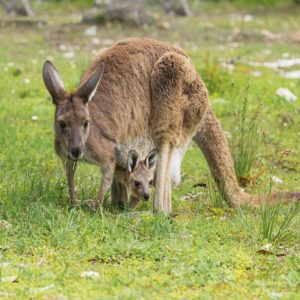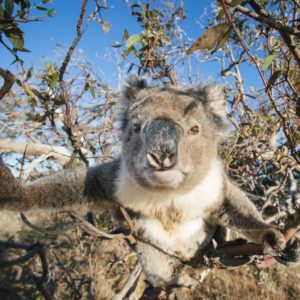Australian Wildlife Week is every week with Australian Coastal Safaris...
This week is Australian Wildlife Week, and we’ve decided to jump on board and pay tribute to some of the amazing wildlife that we get to see on tour - whether its Australian Wildlife Week or not! Of course, our ethos aligns well with that of the Australian Wildlife Week - “...to encourage a positive relationship between humanity and nature” so it was really a no-brainer for us. Our Citizen Science initiatives for recording sightings and reporting back to the Eyre Peninsula Landscape Board, as well as our partnership with Australian Wildlife Journeys, has been a great addition to our tours and brand, and honouring the responsibilities we have to protect and conserve this land.
All the way down south, on the edge of this humungous Australian continent, we are incredibly lucky to have such rich ecosystems of native wildlife and habitat (both marine and terrestrial). Australian Coastal Safaris HQ is based out of Port Lincoln, South Australia, and is the starting point for any adventure into the native wilderness along this coast, or inland. Just take a hop, skip, and a jump...and you’ll find native Mallee bushland, sand dunes dotted with Samphire, salt lakes edged with Paper-bark trees, cliffs rounded with Nitre-bush, and beaches lined with Coastal Pigface. Not only that, but the animals making homes in these beautiful landscapes are just as spectacular as the views are of our ocean and natural landscapes. As the weather starts to warm up, spring flowers emerge, and everything starts wearily stumbling out of hibernation... we thought we’d get you in the mood with some fun facts on our most commonly seen beauties.
Enter stage left; boxing ‘roos, dropbears, and big birds…

The Boxing Roo - aka the Western Gray Kangaroo (Macropus fuliginosus)
- If you didn’t already know that Australia is home to 4 species of kangaroo...well, now you do. However, as well as the usual Red Kangaroo, Eastern Gray, Western Gray, and (probably lesser known) Antilopine Kangaroo - the Macropodidae family also includes tree-kangaroos, wallabies, wallaroos, quokkas and pademelons. Down here on the Eyre Peninsula, the Western Gray kangaroo has made its home.
- The name ‘kangaroo’ originates from the aboriginal word ‘gangarru’ in Guugu Yimithirr language (far north QLD).
- And yes, the rumours are true - kangaroos can get HUGE and pick a fight too...growing up to 7ft tall with a tail of up to 1m long. The males pick fights with each other (called ‘boxing’) to compete for fertile females - hence the ‘boxing roo’ and ‘bush boxing ring’ references...sorry, not sorry.
- Altho such large and (sometimes) intimidating animals, communication is done via a series of soft clicks. Kangaroos have also recently been found to ‘communicate’ with humans...we’re yet to talk to Skippy about this but the rumours are true...
Want to get out and about, and see the local Kangaroo mobs? We run Nature + Wildlife tours - check them out!
Dropbears! Just kidding - the Koala (Phascolarctos cinereus)
- The famed ‘drop bear’ character that is boasted in many tall tales of unique Australian wildlife...is not technically a bear. They are related to the classic Australian Wombat (many times removed) - which lets be honest, also looks like a big cuddly bear.
- Because the koala diet consists of low nutritional value and high fibre, they can only absorb 25% of what they consume - and they spend most of the day digesting and sleeping because it uses so much energy to do so. They are also a little picky - only eating 50 species of the 700 eucalyptus found in Aus. And of those 50...usually they stick to 1-3 species regularly and go for the youngest freshest leaves available on the tree.
- Koala fingerprints - yep, you heard right. Primates, humans and koalas are the only animals that have them - and they are all unique. Unique patterns on their noses also help biologists identify between different individuals.
- Mature males have scent glands on their chests which they rub on trees to release a sticky substance and mark their territory. Territorial ranges will depend on sex, age, social position and habitat quality.
Want to get out and about, and see the local Koala residents? Join one of our Nature + Wildlife tours - check them out!


Big Bird - aka the Emu (Dromaius novaehollandiae)
- The Emu is a part of the oldest group of living birds in the world. This group consists of flightless birds (aka Ratites) which also include the Cassowary, Ostrich, and Rhea. The Cassowary is the closest living relative to the Emu, and is found in north QLD. Ostrich + Rhea are found in Africa.
- Stay-at-home-dads are how the chicks are reared! The female lays her eggs, and then nicks off. The male will incubate and raise the young all by himself. While the male is incubating the eggs, he won’t leave the nest - not even to take a drink break, eat anything, or even go to the toilet...no joke. The incubation period lasts for about 56 days...
- The Emu is Australia's tallest native bird, standing at 1.6-1.9m tall. This is the second largest bird in the world after the Ostrich! These birds are nearly fully grown at 12 months, and they can reach speeds of up to 50km/hr, with strides of 3m.
Want to get out and about, and see the local Emus? Come on one of our Nature + Wildlife tours - check them out!
Other native Aussie species that we see on tour include;
- Rosenberg’s Goanna
- Australian Sea Lion
- 100s of bird species
- Echidna
- Humpback + Southern Right Whales
- Bottlenose + Common Dolphins
There are so many ways that you can see and experience the native Australian wildlife on a tour with us - click here for more information and options. If you’re looking for something more specific, email us - we love creating tailor-made tours just for you.